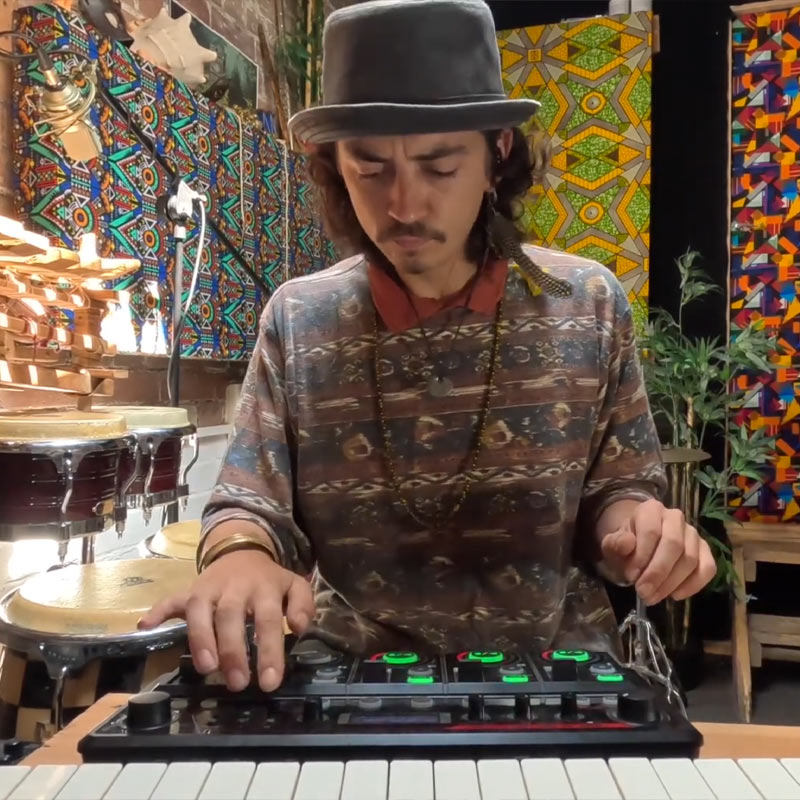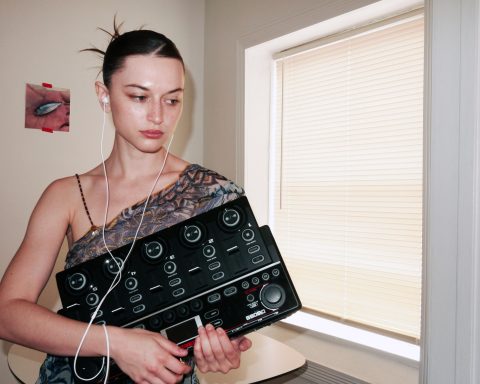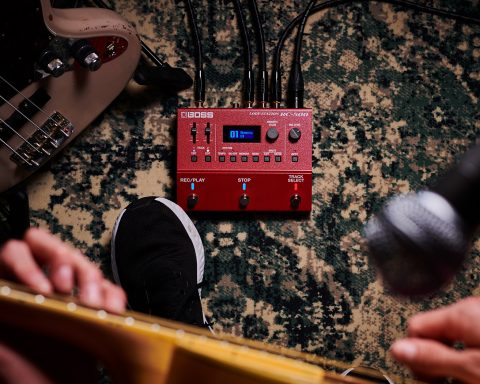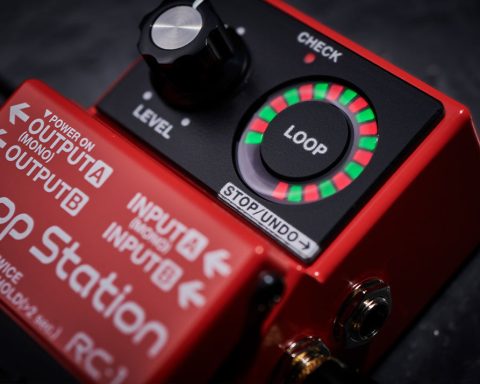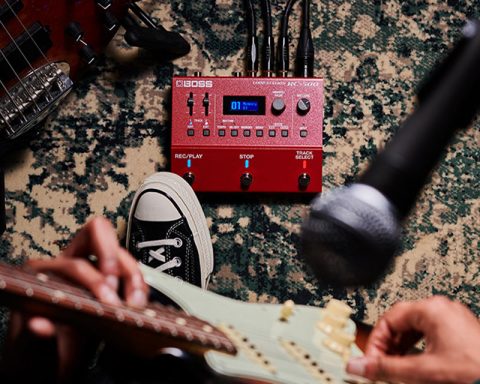If you’re new to looping and you’re a multi-instrumentalist unsure of which looper to get first, which tabletop or floor-based loopers to get first, this guide will help you understand which looper you might need and then show you how to get the most out of loop pedals in live settings (and in studio and rehearsal). We’ll cover looping basics for multi-instrumentalists, choosing the right BOSS looper pedal for different types of performers, advanced looping techniques for live shows, and practical tips for looping on stage. Whether you’re a beginner looking for easy loop pedals or an advanced looper seeking new tricks, this guide will help no matter what instrument you play.
To the Stratosphere
Multi-instrumental performers, including electric violin players, guitarists, keyboardists, drummers, beatboxers, spoken word artists, and horn players, are using loop pedals more and more to create incredible live performances and get stratospheric followings on social media doing so. No longer are artists restricted by who they can work with or when they can “get the band together” because you can create full compositions on your own with a loop pedal.
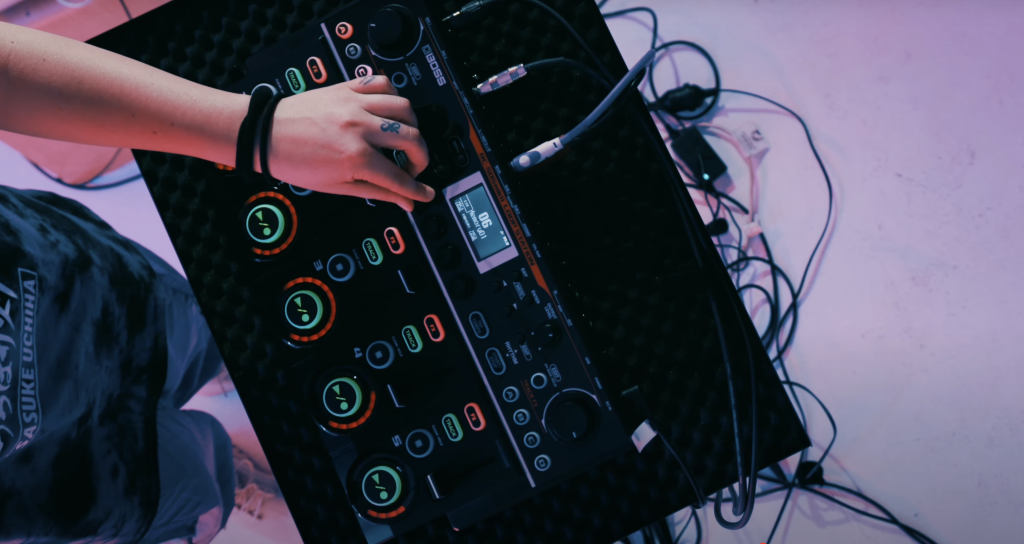
Loop Pedals Basics
Looping is the art of recording a phrase of music live and repeatedly playing it so you can layer multiple sounds on top of each other. For multi-instrumentalists, use a looper to play guitar, loop it, layer over a cello part, and add a drum pad or brass instrument. For beatboxers who also use instruments, you might sing, rap, or beatbox into a mic, trigger the loop, sing over the top, and then layer on a bass guitar or drum pad.
How a Loop Pedal Works
- Record: Press the hand or footswitch and begin playing or singing your phrase. If you’re not using your hands when performing (e.g., beatboxers or spoken word artists), you can manually trigger the button on the RC-505mkII. If your hands are occupied with an instrument (e.g., guitarists, violinists, drummers), use the floor-based looper footswitch for hands-free control. Press the switch a second time to stop recording at the end of the musical phrase.
- Playback: When you stop recording, the loop immediately begins playing back. This lets you hear what you’ve just recorded and start improvising or layering new sounds.
- Layer: Now comes the fun part! With the initial loop playing, you can add another instrument, drum loop, beatbox, rhythm, or vocal harmony on top. Press the switch again, and now both layers will play together. You can continue adding more parts and independently building a fully arranged piece.
Pro tip: The key is timing; you need to trigger the pedal precisely at the right moment to get a seamless loop, which takes practice.
Floor-Based and Tabletop
We will be discussing two different types of loopers: floor-based and tabletop. Both do basically the same thing, except one requires your hand and the other your feet.
Floor-based loop pedals or stompboxes like the BOSS RC-1, RC-5, RC-10R, RC-202, RC-500, and RC-600 sit on the floor for hands-free control with your feet. These are great when playing an instrument like a guitar or bass.
Tabletop loopers, like the BOSS RC-505mkII, sit on a desk and are operated with your hands; they’re popular with beatboxers, vocalists, and producers who aren’t tied to an instrument in hand during looping.
For multi-instrumentalists, loop pedals are connected like this:
Microphone/Instrument → Loop Pedal → Speaker/PA System.
Multi-instrumentalists can use loopers to become a “one-person band.” Here are the basics of how loopers are used by performer type:
What kind of performers and multi-instrumentalists would use loopers?
Multi-instrumentalists and Performers
Perhaps the most famous multi-instrumentalist and performer is Reinhardt Buhr, who uses the BOSS RC-505mkII to loop his instruments as part of his incredible performances—watch the video below. This video shows how he uses the hand-based/tabletop looper to capture loops and build entire compositions, including ng drums, electric cello, guitar, keyboard, and his voice.
Bassists
Loop a chord progression or groove to solo over. For example, bassist Victor Wooten lays down a bass groove and improvises. This helps you develop a tight rhythm and explore harmonies while the original riff “locks down” the groove.
Keyboardists and Vocal Artists
Play a piano or synth chord vamp, loop it, then switch to a lead sound to play a melody. With a looper, a keyboardist can accompany themselves with layered strings, pads, electronic beats, or vocals. Watch Marc Rebillet give a masterclass on how to funk with the BOSS RC-500 below.
Beatboxers and Vocal Performers
Artists like BreZ use loopers to stack vocal basslines, beatboxed drums, and harmonized melodies on the fly. A looper becomes an instrument itself. Lay down a mouth-made beat, loop it, add a vocal harmony line, and then sing or speak over the growing beat. Tabletop loopers like the BOSS RC-505mkII are popular in this crowd for hands-on control, but foot pedals can work, too, if you want hands-free operation.
Guitarists
Guitarists use loopers in many ways, including looping guitar lines over chords, adding beats by hitting the strings, and then layering over vocals.
The most viewed loop video ever is the one above by Tash Sultana, using the RC-20. You can see how Tash plays chords and riffs, then loops lead lines and vocals over the top, giving the illusion that she’s playing with multiple band members.
Drummers and Percussionists
Drummers and percussionists can use a looper to record a percussion pattern (acoustic or using electronic pads) to form the rhythmic backbone. A drummer might loop a beat on an electronic drum pad, then play live drums on top for a fuller sound and loop guitars over them. If you’re a percussionist, you can tap drumstick patterns on a surface or use shakers to create loops.
In addition, drummers can hook up their mics to the BOSS RC-505mkII and play along to full racks. Watch as Christoph Koller builds an entire track with guitar, keyboard, bass, and drums, showcasing one of the best uses of a looper for multi-instrumentalists.
Horn Players
You can record a horn riff or sustained note, loop it as a drone or rhythm, and then play a solo line over it. Horn players use loopers to harmonize with themselves, creating brass sections from a single trumpet or sax. It’s a great way to practice improvisation. Record a chord vamp on a looping keyboard or guitar, then try different horn solos over the repeating progression.
What is the Best Loop Pedal for Multi-Instrumentalists and Performers?
BOSS RC-600
Ideal for: Multi-instrumentalists who need maximum control and flexibility.
Features:
- 6 independent stereo tracks, allowing multiple instruments to be looped separately.
- XLR mic input with phantom power for high-quality vocal looping.
- Advanced routing and MIDI sync to integrate external instruments seamlessly.
- DAW-friendly with USB/MIDI for importing and exporting loops.
- Expansive built-in effects for real-time processing of different instruments.
Benefits for multi-instrumentalists: The RC-600 is ideal for those who perform with multiple instruments and need separate track control. It is a must-have for professional musicians looking for the ultimate looping powerhouse.
"The RC-600 is ideal for those who perform with multiple instruments and need separate track control."
BOSS RC-505mkII
Ideal for: Performers who need hands-on control, beatboxers, vocalists, and synth users.
Features:
- Tabletop design with five independent stereo tracks for layering live loops.
- Dedicated mic input with built-in effects tailored for vocals and instruments.
- MIDI and USB connectivity for DAW integration and live syncing.
- Extensive onboard effects for real-time sound manipulation.
Benefits for multi-instrumentalists: The go-to looper for beatboxers, vocalists, and electronic musicians who prefer hands-on, button-based control over their loops. A favorite for live looping and studio production.
BOSS RC-5
Ideal for: Compact, floor-based looping for guitarists, keyboardists, and mobile performers.
Features:
- Portable and foot-controlled, making it perfect for live gigs.
- Stereo inputs and outputs to integrate multiple sound sources.
- 99 memory slots for storing and recalling loops.
- USB connectivity for DAW use and loop importing/exporting.
Benefits for multi-instrumentalists: This is a smaller but powerful option for performers who don’t need multiple tracks but want high-quality looping and DAW compatibility.
Suppose you need the most flexible and powerful looper for live multi-instrument performance, advanced routing, and DAW integration. In that case, the RC-600 is your best option if you’re going to be playing a lot of instruments. If you prefer a tabletop setup for hands-on control, go with the RC-505mkII. If you need something compact yet capable, the RC-5 is a great choice, too, as it allows for various instruments and inputs.
Why Should Multi-Instrumentalists Use Loop Pedals?
Loop pedals are fantastic tools for multi-instrumentalists and performers because they let you create entire tracks using any instrument you want, by yourself. All you really need is a mic, a few connections, and the courage to actually do it, and you can build songs on the fly, creating full live shows, as highlighted in the videos above. Plus, they’re really easy to start experimenting with and a lot of fun.
Here are some more reasons:
- Create full arrangements live: You can build layered compositions with multiple instruments unrestricted by other musicians—it’s a complete DIY approach.
- Improve timing and performance: An underrated benefit of working with a loop pedal is that looping helps refine your rhythm, making you a better musician.
- Enhance live shows: Looper pedals are excellent tools for adding dynamic sections to songs and can be used to build tracks for your show.
- Boost creativity in rehearsals: A looper allows you to experiment with arrangements on your own or with other musicians before performing those parts live.
- Record ideas instantly: If you don’t have a home studio setup, you can use a looper to capture musical ideas on the fly.
- Affordability: Looper pedals are available for all budgets, and you can use one instead of hiring other musicians or using a recording studio.
"Loop pedals are fantastic tools for multi-instrumentalists and performers because they let you create entire tracks using any instrument you want, by yourself."
Tips for Getting Started with Loop Pedals
Here’s a quick start guide to getting the best sound and starting with a loop pedal.
- Use a metronome or rhythm guide: This is key. See the Victor Wooten videos! Timing is everything. Use the looper’s built-in click or drums to stay in sync, especially when switching instruments mid-performance.
- Start simple: Build one layer at a time. Loop a rhythm guitar part, then add a bass line or vocal harmony once it’s locked in. For example, loop a keyboard chord progression, then switch to a solo over it—keep it simple first and build the track.
- Get creative with effects: Once you’re confident with your sounds, start using reverb on vocals, delay on trumpet lines, or pitch-shifting your voice into a bass line. Effects make each layer stand out in the mix and ensure everyone hears the different instruments.
- Nail your timing and transitions: Practice starting and stopping loops cleanly. Think 1,2,3,4, in your head, and press the hand or footswitch on the first beat. Those switches must feel seamless if you move from beatboxing to playing guitar.
- Plan your set: Think in sections: verse, chorus, breakdown. Know when each instrument comes in, and your performance will be tight. Then, consider how each section can shape the live dynamic, build pressure, and elicit emotion. This is why Tash Sultana, Ed Sheeran, and Reinhardt Buhr are so successful—they think about each loop as part of their set.
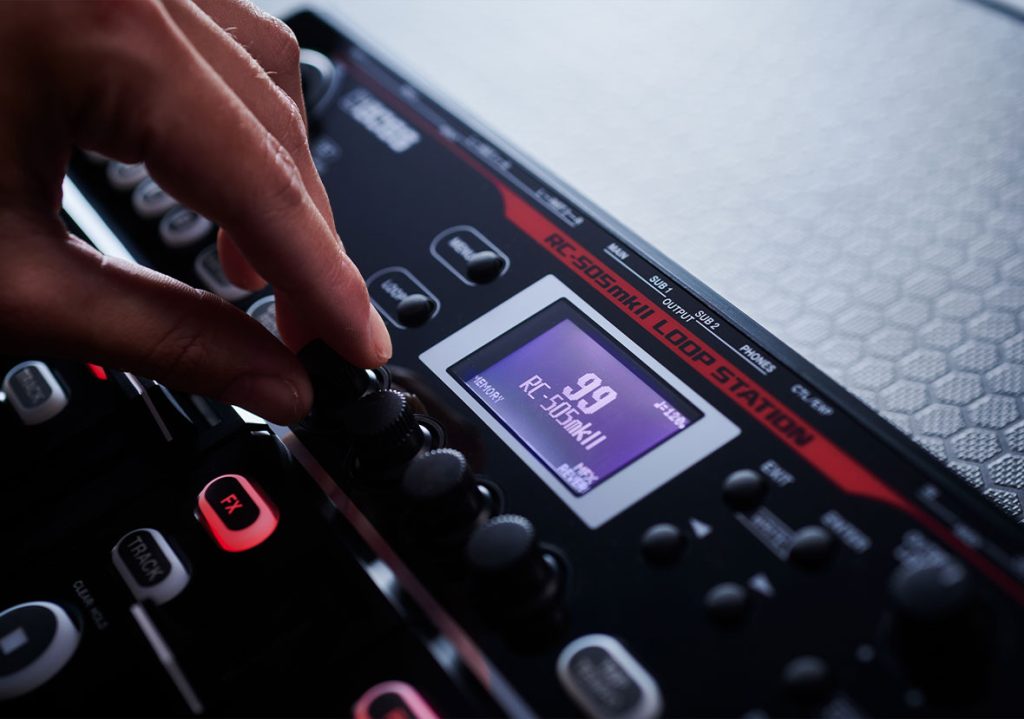
Advanced Loop Pedal Features for Multi-Instrumentalists and Performers
Some cool loop pedal features are designed for performers and multi-instrumentalists who want to get into the nitty gritty of their loop pedals. Here’s a quick rundown of some advanced features you might want to use.
Routing and Input Control
- Multiple Inputs: Use different inputs for different instruments (e.g., an electric violin in one, a mic in another for your saxophone). The BOSS RC-600 and RC-505mkII let you assign inputs to individual tracks, so your sax loop doesn’t get recorded over your synth pad. Use the onboard Effects (Reverb, Delay, Modulation, etc.).
- Reverb and Delay: The BOSS RC-505mkII, RC-600, and RC-500 loopers are all packed with BOSS onboard effects that can be applied to your loops in real time. You can add lush reverb to vocals, delay to a trumpet solo, or modulation to guitar layers to make each loop stand out. You can also apply different effects to each track or input, perfect if you’re looping a mix of instruments live.
- Input FX per Instrument: Compression on your bass track, reverb on your vocals, EQ on your drums, and do it all from one looper, saving much pedalboard space.
Track Management
- Multitrack Looping: Use separate tracks for different parts of your performance, like the verse, chorus, and solo. The RC-600 has six stereo tracks, perfect for layering multiple instruments.
- Track Switching: This is great for live builds and transitions. You can Trigger one loop while fading out another or drop it out completely and bring it back in when the chorus hits.
MIDI and DAW Sync
- MIDI Sync: Keep loops in time with drum machines, synths, or sequencers. This is great if you’re switching between live and electronic instruments.
- DAW Integration: Record loops into your DAW or trigger backing tracks you’ve prepped in advance. The RC-505mkII, RC-600, and RC-500 all support USB AUDIO/MIDI.
Backing Tracks and Loop Storage
- Load Backing Tracks: Perform live over pre-prepared stems or loops. The RC-500 and RC-505mkII make this easy, and you can trigger pre-recorded loops and backing tracks, so you don’t have to build them live.
- Save Loop Phrases: Store your best ideas or live sets and recall them before a gig, which is perfect if you play multiple instruments across multiple songs.
Frequently Asked Questions about Loop Pedals for Multi-Instrumentalists and Performers
What’s the best loop pedal setup for an acoustic violin?
The best loop pedal for a violin is any looper with an XLR input so you can connect a mic to it like the RC-202, RC-500, or RC-600. However, if you’re using an electric violin, any looper in the BOSS range will be perfect, as they all have line-level inputs.
What is a multi-track looper?
A multi-track looper is a piece of equipment that allows you to record on two or more tracks that can operate simultaneously. You can record and play any number of tracks simultaneously or trigger them independently.
"A multi-track looper is a piece of equipment that allows you to record on two or more tracks that can operate simultaneously."
What’s the best Loop Station for a live multi-instrumentalist?
The best Loop Station for multi-instrumentalists is the BOSS RC-600 or the RC-505mkII. The RC-600 suits live multi-instrumentalists needing foot control, six stereo tracks, MIDI sync, and USB/DAW integration. The RC-505mkII is ideal for tabletop performers needing tactile control, five stereo tracks, flexible routing, and real-time effects. Both offer gig-ready solutions that sync effortlessly with external gear.
The RC-600 is for multi-instrumentalists who play with their hands, such as guitars, basses, etc. With six stereo tracks, MIDI sync, advanced routing options, and USB/DAW integration, you can plug in your instruments and mic, even sync a drum machine or synth, and build your set live, seamlessly switching between parts.
The RC-505mkII is the best looper for multi-instrumentalists who want to trigger with their hands. It is perfect for tabletop setups, beatboxers, keyboardists, or anyone working with live synths and vocals, drum machines, etc. It has five stereo tracks, assignable effects, and ultra-flexible input/output routing. It’s ideal if you need visual feedback and tactile control; it syncs with MIDI devices and lets you trigger loops, mutes, and FX on the fly.
What is the best Loop Station for synths?
The best loop pedals for synths can loop synths in stereo, sync with MIDI, and layer sounds live, namely the BOSS RC-5, RC-505mkII, and RC-600. Use the RC-5 for compact setups with stereo I/O, MIDI sync, 99 memory slots, and 13 hours of recording. Choose the RC-505mkII for hands-on control with five stereo tracks, onboard effects, and USB/MIDI. Select the RC-600 for complex rigs with six stereo tracks, assignable effects, deep routing, and expression pedal support.
Loop Station Fun
Loop pedals can change the way you play music, change the way you write, and change the way you perform for the better. They’re great tools that can become part of the performance and write tracks independently, free from the constraints of rehearsal. There’s a Loop Station for you, whether you’re just starting out looping a ton of instruments with the RC-500 or pushing the boundaries of your vocals and synths with the BOSS RC-505mkII.
Want to dive deeper into looping? Visit our Loop Station hub for more insights, tips, and resources.
